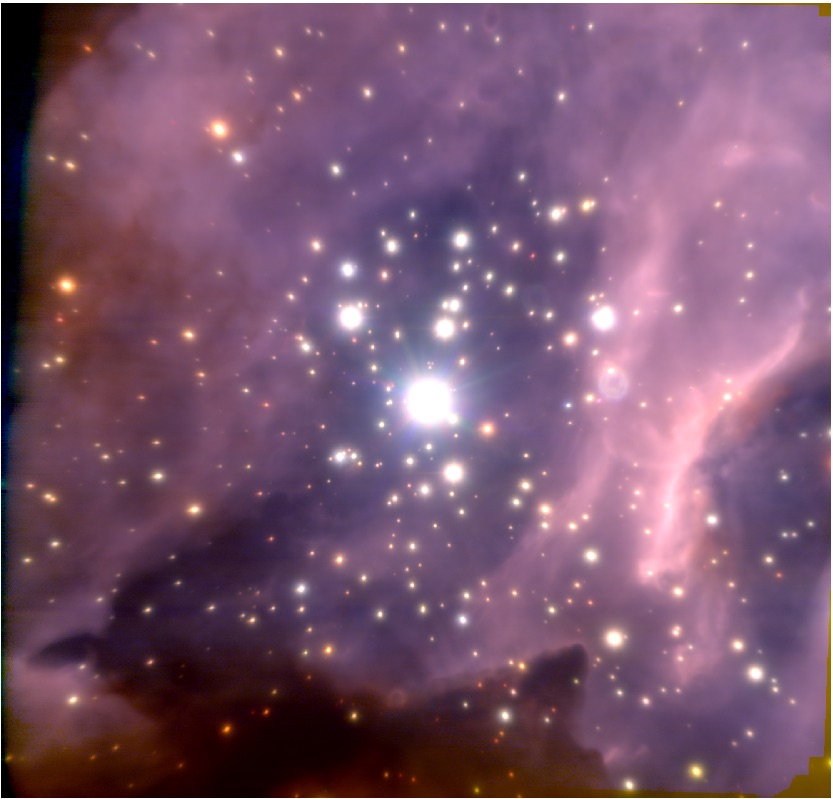TORONTO, July 6, 2017 – Our galaxy could harbour some 100 billion brown dwarfs, often described as “failed stars,” reveals new research by an international team of astronomers, including York University’s Ray Jayawardhana in the Faculty of Science.
Brown dwarfs are objects intermediate in mass between stars and planets, with masses too low to sustain stable hydrogen fusion in their core, the hallmark of stars like the Sun.

False-colour near-infrared image of the core of the young massive cluster RCW 38 taken with the adaptive-optics camera NACO at the ESO's Very Large Telescope. RCW 38 lies at a distance of about 5500 light years from the Sun. The field of view of the central image is approximately 1 arc minute, or 1.5 light years across. (Photo by the research team )
From their survey, the seven-member research team estimates that our galaxy, the Milky Way, has at least 25 billion to as many as 100 billion brown dwarfs. Even this could be a significant underestimation, as there are many lower mass and fainter brown dwarfs, present everywhere in star clusters, they note.
“It seems that brown dwarfs form in abundance in a variety of star clusters,” says Jayawardhana. “They are ubiquitous denizens of our Milky Way galaxy.”
Jayawardhana and the team have come to the conclusion after surveying brown dwarfs in a massive star cluster, noting this is probably typical of the environment where most stars in the galaxy form.
The researchers found that there is approximately one brown dwarf for every two stars in the cluster, similar to the ratio they had found previously in nearer, less dense star clusters.
They present the findings today at the National Astronomy Meeting in the UK. Lead researcher Koraljka Muzic at the University of Lisbon and team member Aleks Scholz at the University of St Andrews have collaborated with Jayawardhana since their time as postdoctoral fellows in Jayawardhana’s group.
Scholz says: “We’ve found a lot of brown dwarfs in these clusters. And whatever the cluster type, the brown dwarfs are really common. Brown dwarfs form alongside stars in clusters, so our work suggests there are a huge number of brown dwarfs out there.”
Since the discovery of the first brown dwarf in 1995, astronomers have identified thousands more. The overwhelming majority known to date reside within 1500 light years of the Sun, relatively nearby astronomically speaking, simply because brown dwarfs are intrinsically faint and difficult to observe at greater distances.
Back in 2006, Jayawardhana and his collaborators began a new search for young brown dwarfs. After surveying five nearby star-forming regions, they turned their attention to the more distant RCW 38 star cluster, which has a high density of more massive stars and very different conditions from the other surveyed regions.
The fact that they have found just as many brown dwarfs in RCW 38 suggests that the environment where the stars form, whether stars are more or less massive, tightly packed or less crowded, has only a small effect on how brown dwarfs form.
For the current study, the researchers used the European Southern Observatory’s Very Large Telescope in Chile to target the RCW 38 cluster, located 5500 light years away from the Sun. They used an adaptive-optics camera to capture sharp images, considering the cluster’s distance and the proximity of the faint brown dwarfs to bright and massive stars.
The RCW 38 study has been submitted to Monthly Notices of the Royal Astronomical Society. Preprint is available at https://arxiv.org/abs/1707.00277
York University is known for championing new ways of thinking that drive teaching and research excellence. Our students receive the education they need to create big ideas that make an impact on the world. Meaningful and sometimes unexpected careers result from cross-discipline programming, innovative course design and diverse experiential learning opportunities. York students and graduates push limits, achieve goals and find solutions to the world’s most pressing social challenges, empowered by a strong community that opens minds. York U is an internationally recognized research university – our 11 faculties and 26 research centres have partnerships with 200+ leading universities worldwide. Located in Toronto, York is the third largest university in Canada, with a strong community of 53,000 students, 7,000 faculty and administrative staff, and more than 295,000 alumni. York U's fully bilingual Glendon campus is home to Southern Ontario's Centre of Excellence for French Language and Bilingual Postsecondary Education.
Media contact:
Gloria Suhasini, Media Relations, 416 736 2100 ext. 22094, suhasini@yorku.ca

